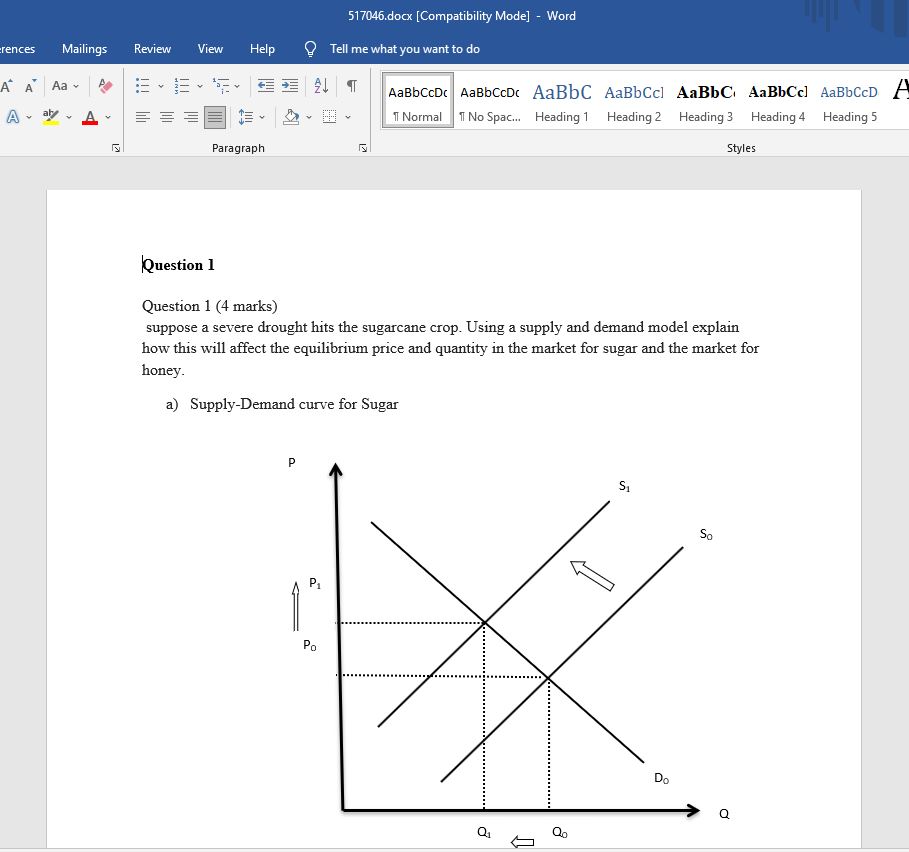Supply-Demand curve for Sugar
While questions 1 to 3 are in short answer format, the answer to question 4 should be in essay format, using the Harvard style of referencing. • For the essay question, write concisely. Get to the point so you can include as many new ideas and arguments as possible. But remember, one point per paragraph and one idea per sentence. • For the essay question, write an introduction to say what you will discuss and a conclusion which sums up the discussion and clearly shows answers to all parts of the question. Remember, before you start writing, break the question into its parts so that you understand everything you have to do. • For the short answer questions, do not include an introduction or conclusion. Just answer the question. • Edit your work. Do not repeat information except to summarise at the end. It is good practice for you to write in a way that provides maximum information in a minimum of space. This is what you are expected to do in the exam, though you won’t have to use references. Remember, the extended response section of the final exam comprises 20 per cent of your total mark for this course and some students just do not write enough solid and relevant material. • Use appropriate assumptions where required. These may help you to simplify any complexity. Selecting appropriate assumptions in economics is considered as a way of making an economic analysis (often called a model) simpler without affecting any of its important conclusions. • Use relevant diagrams wherever possible (for all questions). These are the conventional way in which things are discussed in economics. Fully label diagrams, shift parts of the diagrams to illustrate key points and then explain what is occurring. • Use the textbook to get started. Do some extra reading, from other introductory texts, the Web, newspapers or journals to expand on the initial reading. Your answer for question 4 should contain at least six different relevant references including at least one journal article. Reference the textbook when you use it for information. Assignment questions The assignment consists of three short answer questions (20 marks total) and one essay question (20 marks). Short answer questions (references not needed) Question 1 (4 marks) Suppose a severe drought hits the sugarcane crop. Using a supply and demand model explain how this will affect the equilibrium price and quantity in the market for sugar and the market for honey. Question 2 (8 marks) (a). Complete the following table of costs for the Pizza Company. (3 marks) (b). Draw the total cost curve on one graph. On another graph, draw the marginal cost, average total cost and average variable cost curves. (3 marks) (c). Are there output levels that exhibit increasing returns to scale? (1 marks) (d). Are there output levels that display decreasing returns to scale? (1 marks) Pizzas Fixed costs Variable costs Total costs Marginal costs Average total costs Average variable costs 0 $1000 $—– 200 $1000 $360 400 $1000 $840 600 $1000 $1440 800 $1000 $2160 1000 $1000 $3000 1200 $1000 $3960 1400 $1000 $5040 1600 $1000 $6240 1800 $1000 $7560 2000 $1000 $9000 Question 3 (8 marks) (a). What will happen to the bakery if a large retailer like Coles or Woolworths establishes a new store in a location close by and decides to price bread below cost as an opening special to attract customers? What will happen to the bakery if the new retailer continues this pricing behaviour for, say, one year? (4 marks) (b). How should a monopoly choose its quantity of production to maximise profits? Explain why producing either less or more than the level of output at which marginal revenue equals marginal cost will reduce profits. Since a monopolist does not fear competition, what prevents it from raising its price as high as it wishes to make higher profits? (4 marks) Question 4 (20 marks) (references needed) A government implements heavy taxes on sugar-sweetened beverages (sugary drinks), as part of a comprehensive approach to decreasing overweight and obesity. You are required to write an essay to discuss this issue. Make sure that you clearly address the following questions in your analysis: 1) Using the supply and demand model explain why a tax can reduce the sales of sugar-sweetened beverages. 2) Explain whether the demand for sugar-sweetened beverages is elastic or inelastic. 3) Explain if an alternative policy such as a price floor policy (or any other policy) works in reducing the sales of sugar-sweetened beverages. 4) Critically evaluate or predict the effectiveness of the sugar-sweetened beverage tax as a policy in reducing the number of people drinking sugar-sweetened beverages.
Question 1: Suppose a severe drought hits the sugarcane crop. Using a supply and demand model explain how this will affect the equilibrium price and quantity in the market for sugar and the market for honey
Sugarcane production is normally done in area with high rainfall level. But, severe draught that hit the sugarcane crop farming has an impact of decreasing its yields and increasing its production expenses. The ancillary expenses incurred during draughts periods includes expenses related to irrigation such water bills, irrigation system equipment’s and finally personnel manning the irrigation system.
On the other hand, bees rearing can still be undertaken during periods of severe draughts. Thus, draught has little or no impact on bee farming. Hence, the supply of honey will not be interrupted as a result of severe draught striking that area where it is undertaken under.
Honey supply will thus not be affected by the severe draught hence its supply will remain constant for the foreseeable future. Whereas the supply of sugar will be affected due to the climatic condition experienced. Its supply will decrease due to decrease in its yield. This will result to a shortage in supply which will lead to an increase in its price.
Answer preview:
Word: 2,100

